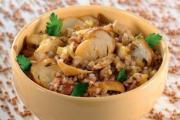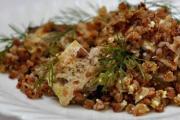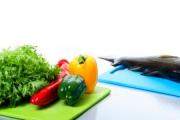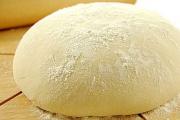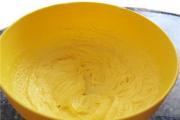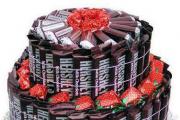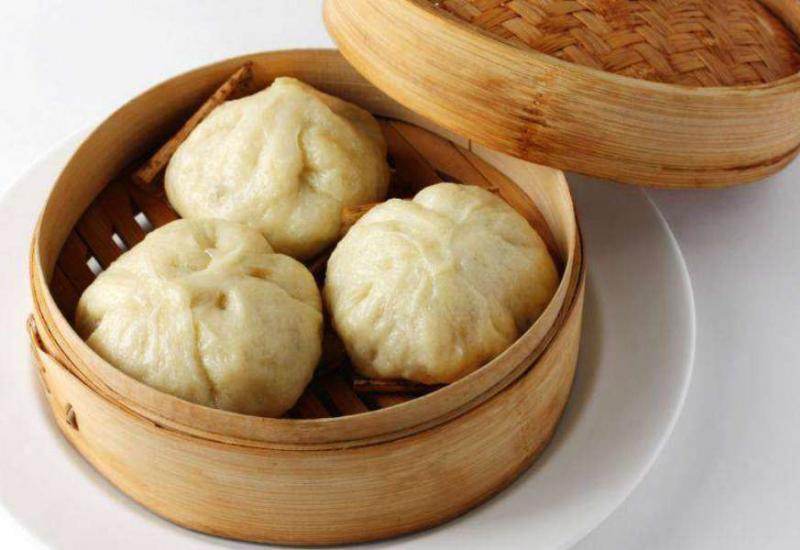Italian ciabatta tortilla recipe for home cooking. Ciabatta bread - useful properties and calorie content. How to bake a ciabatta at home
Ciabatta Is a delicious rustic Italian bread baked in the shape of a baguette. It has a very thin crunch and a porous crumb that looks exactly like the picture in the cut. Translated from Italian, the name of this product means "slippers", which is quite consistent with the shape of the product.
Airy bread is loved by everyone, without exception, because it is quite satisfying. But do not forget that ciabatta, like any other bread, has a high calorie content. It cannot be otherwise, because the ciabatta contains wheat (less often rye) flour, sourdough or yeast and olive oil, which provides airiness to the dough.
The recipe for this product has been passed down from generation to generation, so you can taste a real ciabatta to this day. And you do not need to visit Italy for this, because the product has long spread throughout the world.
Nourishing sandwiches, sandwiches and bruschetta are prepared on the basis of this tender bread, and tender and almost weightless buns for hamburgers and bouchet are baked using airy dough. Crackers made from a slightly dried loaf also have an amazing taste. They can be used both as a standalone product and for preparing a light vegetable salad.
Supermarkets and hypermarkets that have a cookery and their own bakery often offer Italian bread. The price of baguettes is quite acceptable, and in some retail chains it is generally possible to order home delivery of pastries. You can also purchase frozen semi-finished ciabatta and a mixture for its preparation, which is a dry blank containing gluten and enzymes.
Preparation
Cooking a ciabatta is a simple but lengthy process. It is like baking traditional bread. Initially, it was cooked in stone ovens, but technical progress has made its own adjustments, and modern housewives are no less successful in preparing the product in multicooker, bread makers and ovens.
The dough preparation technology has not undergone any significant changes in modern conditions. It has become a kind of GOST. Real Italian bread is still made with a leavened yeast culture. The dough fermentation process takes about twelve hours, but this is what allows the bread to be unlike all other baked goods.

Real ciabatta
How to bake a correct and tasty ciabatta at home, we will tell you in this section of the article.
The basis for obtaining high quality real Italian bread is kneading. It can be produced either manually or by using dough mixing units. A separate place in the preparation of the product should be given to the correct parting of the dough, so do not neglect the advice. Only if you follow the technology you will be able to get the baked goods that are as similar to the original as possible.
The main, one might say, the classic method of kneading Italian bread is called the method based on the preparation of dough with successive kneading of dough. Italians call it Bige. In our understanding, this particular method is the most suitable for obtaining high-quality baked goods.
To do this, you need to knead the batter, which, after complete proofing, will need to be mixed with the bulk of the flour. To get a bige you need to mix:
- 85 grams of rye and wheat flour of the highest grade;
- 140 ml warm water;
- 4 grams of compressed fresh yeast.
The resulting liquid mass must be kept for an hour and a half at room temperature, and then placed in the refrigerator for 20 hours. It will turn out dark and have a malt flavor.
After the time has passed, add this mass to a bowl with four hundred grams of sifted flour, and then add more there:
- 210 ml of water;
- 70 ml of milk;
- 30 ml deodorized vegetable oil;
- 10 grams of granulated sugar;
- 25 grams of fresh yeast;
- 14 grams of table salt.
It is recommended to dissolve loose components in water, and yeast in milk. Knead the dough well and leave it warm for another two hours. After that, divide the blank into four equal parts and form oblong buns. Spread the bread on the parchment and let sit for another 10 minutes. Bake the ciabatta for 25 minutes at a temperature of 200 degrees Celsius and place the trays in an already preheated oven.
After baking, remove the ciabatta from the sheets and cover with a damp linen or cotton towel. Soak the product for 20 minutes and boldly serve it!
Quick ciabatta
Of course, the process is very lengthy, and not all housewives will want to repeat it. Therefore, we suggest that you familiarize yourself with the second recipe, which many cooks know as a quick ciabatta.
So, let's study the preparation of ciabatta in the most simple, safe way. For one large loaf of bread, mix in a deep bowl:
- 430 grams of sifted premium wheat flour;
- 330 ml of cold water;
- one teaspoon of salt;
- 1 tablespoon of unscented olive or vegetable oil
- 1 sachet of dry yeast.
Some culinary experts use grated dried herbs to add flavor and flavor to the dough.
From this amount of products, a batter will be obtained, which will become denser in the process of flour separation.
Cover the bowl with cling film and wrap with a towel. The product should be in this state for at least six hours, while the minimum holding time for the mass in the previous recipe is fifteen hours.
After the dough is completely fermented, it is taken out on a board dusted with a small amount of flour and kneaded. A well-performed action allows you to squeeze out excess air from the dough and at the same time form the correct shape of the workpiece. To do this, the dough is leveled into a thin layer, and then they begin to fold it into an "envelope", while pressing it well against the table. By doing this manipulation, you will see the movement of air in the dough. Pierce very large bubbles.
The moisture content of the dough plays an important role in the preparation of puffed ciabatta. It is the loose "live" kneading that makes large holes and a springy crumb in the finished product. To prevent the dough from sticking to your hands, brush them with a little vegetable oil, but in no case use flour for this purpose.
After the dough is the size you want, carefully transfer it to the parchment. Then bake the ciabatta. In the oven, set the temperature to 180 degrees Celsius, and in other ovens, select the mode for standard yeast baked goods. The heat treatment time of the product in any case should not exceed thirty minutes. Do not expect a golden brown crust - this bread will not have it. The readiness of a product can be judged by its other external signs: an increase in volume and drying of the top layer of the product, and also by the delicious aroma that will fill your home.
Likewise, you can bake a ciabatta stuffed with fried onions. Pastries with olives and suluguni cheese will take pride of place on the table. This bread is best eaten warm immediately after cooking, while the classic ciabatta tastes better when it is cold.
Many housewives have long discovered the preparation of yeast-free bread with whey with the addition of whole grain flour. It is called the ciabatta integral. In terms of consistency, such a dough turns out to be very similar to both previous options, but the baked goods differ from the real product in their pronounced curd taste and exceptional usefulness.
Whichever of the ciabatta cooking options you choose for cooking with your own hands, in any case, it will turn out to be flawless. If you still have questions, we suggest you watch a video recipe for the step-by-step preparation of this wonderful bread.

What is ciabatta eaten with?
Traditionally, ciabatta is eaten by dipping thin slices of it in olive oil and then washed down with Italian wine. But we use this bread on an equal basis with other flour products and prepare delicious hot and cold sandwiches on its basis, including false pizza. A surprisingly simple, but amazing dish can be made in a matter of minutes by adding a few slices of cheese and garlic to a bun cut lengthwise like shells.
An equally tasty dish of their ready-made ciabatta can be obtained by filling a bun cut in layers from the base or criss-crosswise from above with soft cheese (preferably mozzarella) and juicy tomato slices. Between these products, you need to put several leaves of aromatic basil and parsley. For the proposed recipes, the cooking method is identical: then the stuffed ciabatta must be heated in the oven or microwave and served warm.
Fresh ciabatta slices can be paired with bacon and ham, as well as oily fish species such as tuna and salmon. And what taste does this delicate bread stuffed with pastrami, pickles and thickly seasoned with mustard sauce get? This dish can be an excellent breakfast and satisfy the most fastidious gourmets' gastronomic needs!
Those who calculate the BJU index and calories will love the ciabatta served with grilled vegetables or tender boiled chicken breast.

Benefit and harm
The benefits and harms of ciabatta are due to the chemical composition of the product and the general method of preparation of this Italian pastry.
Italian bread contains all the ingredients found in any bakery product:
- vitamins A and E;
- folic acid and other B vitamins;
- amino acids;
- magnesium;
- potassium;
- phosphorus;
- selenium;
- zinc.
Due to the fact that real ciabatta has a long cooking time, such bread will be easy to digest. It should be noted that it is completely harmless, since the yeast in it is completely decomposed. That is why such a product should be preferred over traditional bread. Eating ciabatta has a beneficial effect on gastric motility. The product is recommended for people suffering from stomach ulcers and other inflammations of the gastrointestinal tract, as well as those who are prone to frequent colds due to reduced immunity. Limiting the amount of ciabatta eaten is worth people suffering from kidney disease and disorders of the excretory system. Eating large quantities of this soft bread by people with gout can be harmful.
The main contraindication to eating ciabatta, which should be announced, is the individual intolerance to the ingredients of the product.
Ciabatta is a real work of art. She is light and flawless, you can't help but love her. Try to make fragrant tender bread according to our recipes. We assure you that while eating ciabatta, you will instantly be transported to a bizarre peninsula to the shores of warm and gentle seas.

17.11.2018
For some, bread is just bread: a flour product with which you can make a morning sandwich in a couple of minutes or which is applied as an obligatory element to a cup of soup. And someone loves to try new types and understands their differences, so they will never call a ciabatta just a loaf. This Italian bread is worth trying at least once, so as not to be able to forget it and want to cook it yourself. But how realistic is it to bake a ciabatta in the oven? There are many recipes, but not everyone succeeds in their successful implementation.
Ciabatta: Key Features
Mixing the ingredients, pouring it into a mold and baking - not at all about a ciabatta: this is a product that requires attention and care. On average, it takes 16-18 hours to cook, which partly provides him with that very specific structure with a large number of holes inside. If you pick up a ciabatta, you will be surprised how light it is, because it is practically hollow and very dry. It is not possible to achieve such a result the first time, so it is not enough just to find a recipe for ciabatta in the oven - you also need to understand the peculiarities of its baking.
- The kneading of the dough after all the components have been mixed should not be less than 7 minutes. The optimal time is 10 minutes. In this case, it is advisable to knead with your hands, and not with attachments in a food processor. The principle is also special: the fingers are spread out and the palms must be practically "tamped" in turn, so that each time it is pressed, it emits air with a dull sound.
- Flour for chibatta must have at least 11.5 g of protein (see BJU on the package), otherwise little gluten will be produced, the desired structure will not be achieved.
- A dense crust, but a delicate crumb is one of the important features of ciabatta, which is achieved by creating the correct humidity in the oven. After it warms up, you need to put a deep baking sheet with boiling water on the lower level - you should not bake the ciabatta without steam.
- The airy structure is ensured not only by long kneading, but also by the correct heating of the dough: ideally, bake the ciabatta on a special baking stone 1.5-2 cm thick. In this case, each centimeter heats up for about half an hour, so the oven “idle” heats up for about an hour before the dough will be sent to it. Without such a stone, it will be more difficult to get the desired holes, although the situation can be partially saved by a large ceramic mold, on which parchment with dough is placed.
To prepare ciabatta, you do not need to look for a special form: in translation from Italian, this bread is called "slipper" and each loaf of it has an individual look. The dough is simply folded several times to a rectangle and baked - if deformation has gone somewhere, this is absolutely normal. This is how a real ciabatta should be.
Oven ciabatta recipe: original from an italian chef
Italian cuisine is famous for its simplicity, so the ciabatta is quite austere in its composition - it uses yeast, flour, salt and olive oil. The base liquid is often water, but some experts say that the crumb comes out more tenderly in milk: this option also exists in Italian cuisine. Nevertheless, the classic recipe is still with water, and it is better to start mastering ciabatta with it.

Ingredients:
- bread flour (with a high percentage of protein) - 560 g;
- water - 440 g;
- dry yeast - 1/2 tsp + pinch;
- salt - 1 tsp;
- olive oil - 2 tablespoons l.
Cooking method:

As for a variety of quick ciabatta recipes (in 2-3 hours), it is better to refuse them right away: the whole essence of this bread is in a long proofing, which ensures the airiness of the crumb. You cannot achieve such an effect in a couple of hours - it is better to try to make focaccia, if there is no extra time.
Nutritional value and composition of Ciabatta bread
Ciabatta bread contains a large amount of folic acid, vitamins E, A and group B. This bakery product is rich in composition of amino acids, among which a special place is occupied by lysine, glycine, methionine, valine, phenylalanine, etc., as well as minerals such like: calcium, phosphorus, zinc, magnesium, etc.
100g of Ciabatta bread contains:
- Proteins - 7.7.
- Fats - 3.8
- Carbohydrates - 47.8
- Kcal - 262.
Ciabatta is a crispy, unevenly pored bread. This type of bread as Ciabatta is used for making sandwiches, snacks, sandwiches. It is served with first courses and salads, combined with cheese, wine and ham.
Interesting facts from the history of Ciabatta bread
The beginning of baking Ciabatta was laid in Liguria, but today this bakery product is baked all over Italy, and in Spanish Catalonia this type of bread is called Chapatta. Ciabatta baked in Tuscany, Marche, Umbria, strikingly differs from one another both in pulp and crust and composition.
The main secret to baking this bread is to use live yeast and raise the dough for 12 hours or more.
The classic Italian Ciabatta is baked in a special oven. Modern housewives use a flattened stone, which is placed in the oven, heated, and then put a baking sheet on it with Ciabatte prepared for baking.
Ciabatta comes in several varieties:
- From whole wheat flour (ciabatta integrale).
- With the addition of olive oil, marjoram and salt.
- Ciabatta with milk (ciabatta al latte).
Useful properties of Ciabatta bread
The Ciabatta dough is aged for about 12 hours. For such a long time, it becomes homogeneous, and the yeast contained in this dough ripens completely. From this, this bakery product is considered useful for people with gastritis, duodenal ulcer, as well as for those who have weakened intestinal motility.
Ciabatta is included in all kinds of diets, because this bread is easy for the stomach, but not in large quantities, since it is high in calories.
Ciabatta bread is useful for a weakened body with low immunity, as well as in the postoperative period.
Making Ciabatta bread at home
Cooking this bread will require patience and perseverance from you, but all efforts will be justified by obtaining an unusually tasty and healthy Ciabatta bread to the surprise and joy of the household.
Ingredients:
- Wheat flour of the highest grade - 430g plus flour for bedding.
- Drinking water - 330 ml.
- One teaspoon of salt.
- Dry yeast - 1g.
Preparation:
- Sift flour, add salt and yeast and stir.
- Pour in water at room temperature and gradually add the flour mixture, stirring with a spoon, but without kneading with your hands until smooth.
- Cover the bowl with cling film and leave to ferment for 12-15 hours. During this time, the dough will gradually grow and bubble - this is a prerequisite for Ciabatta.
- Pour flour on the table and lay out the dough (it is very sticky). Gently wrap all sides of the dough halfway to form a bar.
- The dough spreads, so the folding procedure is carried out carefully several times until you see that the dough does not float, but keeps its shape.
- Divide the dough into 2 parts. Stretch each piece of dough into 10 x 20 cm rectangles. Lay each piece on a natural cloth towel and tuck the edges on all sides to keep the dough from bleeding. Cover the tortillas and leave to rise for an hour. During this time, the dough will not increase significantly, but it will become soft.
- Carefully remove the finished cakes with a cardboard from a towel, and then onto a baking sheet. We put our Ciabatta in an oven heated to 220 ° C and bake for 35 minutes, occasionally sprinkling it from a spray bottle onto the oven walls.
- We take out the finished bread from the oven, put it on the wire rack, cover with a towel and leave it to cool completely. After 30 minutes, the delicious and crispy Ciabatta is ready to be served!
Who hasn’t tried or at least heard about ciabatta - Italian bread with large pores, crispy crust and amazing aroma? It is the ciabatta that is ideal for (grilled sandwiches), for making croutons and croutons, serving with sauces and gravies.
Ciabatta is easily recognizable by its famous rectangular flat shape, reminiscent of slippers. Translated from Italian, the word "ciabatta" is translated as "slipper". A standard ciabatta is made as wide as a palm and 20-25 cm long, and a loaf weighs about 350 grams. Bread of this size can be conveniently cut in half for making sandwiches - it turns out just two decent portions.
Ciabatta is a long-fermented bread. It takes at least 12 hours to cook. Of course, there are plenty of "quick" ciabatta recipes for 3-4 hours. But this bread will resemble a real ciabatta only externally. It is during the long fermentation that the dough acquires a slightly leavening taste, and the gluten becomes stronger, due to which the famous ciabatta crumb is obtained - a little rubbery, elastic, strong, with characteristic pores of different sizes.
The ciabatta dough is not kneaded in the usual way. Since it is very soft, almost liquid, it is inconvenient to knead it, so the finished dough is simply folded in several stages. This is how the ciabatta is given its “signature” shape.
Do you want to know what it is, a real, authentic ciabatta recipe? Come with me to the kitchen - we will bake bread together according to this very recipe.
Cooking time: about 14 hours. Output: 2 loaves
Ingredients for a ciabatta recipe
To bake a ciabatta, you will need:
- 430 grams of flour plus flour for dusting the work surface
- 330 ml water at room temperature
- 1 tsp salt
- 1 gram dry yeast
Preparation

It is very convenient to prepare ciabatta in stages: put the dough for fermentation overnight, and in the morning - shape and bake.
First, combine flour, salt and yeast.

Then sift the mixed dry ingredients into a large bowl so they bond evenly together.

Then pour water into a bowl.

Stir the dough with a spoon until the water absorbs all the flour. No need to knead until smooth. During fermentation, the dough will become homogeneous by itself.

Cover the bowl with plastic wrap and leave at room temperature for 12-15 hours to ferment. During this time, the dough will gradually grow and bubble. The ciabatta recipe in this place is very "strict", this regulation cannot be missed.

Sprinkle flour on the work table very thickly. Do not spare the flour, as the dough is very sticky.
Place the dough on the prepared surface.

Without crushing it, so as not to release the air formed inside, first fold the left side of the dough to the middle.

Tuck the right side in the same way. After that, do the same with the top side.

Tuck the bottom side last. The dough will begin to resemble a bar.

But while it is still very soft and blurry. Therefore, you need to repeat the folding procedure two more times. As a result, you will notice that the dough already holds its shape more - it should be so.

Divide the resulting dough in half.

Gently stretch these pieces of dough so that you have two rectangles about 10 x 20 cm in size.
Take a thick cotton cloth (such as a waffle or linen tea towel), dust it with flour and place the ciabatta on top of it, creating folds between the loaves that will keep the dough from flowing excessively.

Cover the blanks with a towel and let stand for 1 hour. During this time, they should not greatly increase in size, but they will become plump.
Now turn on the oven - it should warm up to 220 degrees along with the baking trays on which you will bake the bread. It is advisable to use convection mode, if available.
To gently transfer the ciabatta to a baking sheet, bring a small board or clean piece of cardboard to it.

With a quick and gentle movement, pull the fabric on which the ciabatta was lying and flip it over onto this board. Keep in mind that the ciabatta should not flop down hard on the board to keep out the precious air.

Then place the ciabatta on a hot baking sheet and quickly place in the oven.

If you have an electric oven, splash water on the bottom to create steam. You can also create steam with a spray bottle by spraying it onto the walls of a hot oven. Be careful not to burn yourself with the steam.
Bake for 30-35 minutes until very golden brown.
When the bread is ready, let it cool for 15-20 minutes, after which you can enjoy this amazing taste of homemade ciabatta. Bon Appetit!





